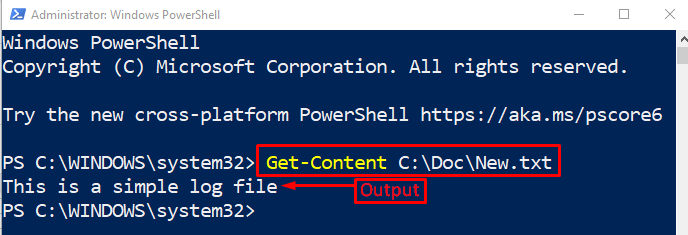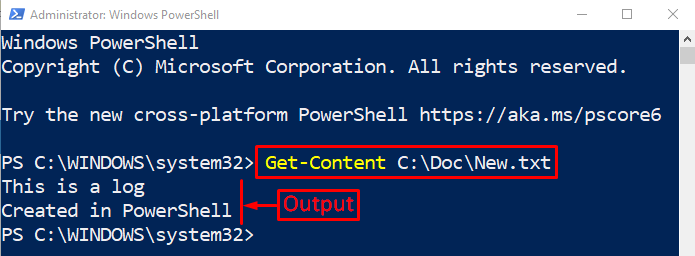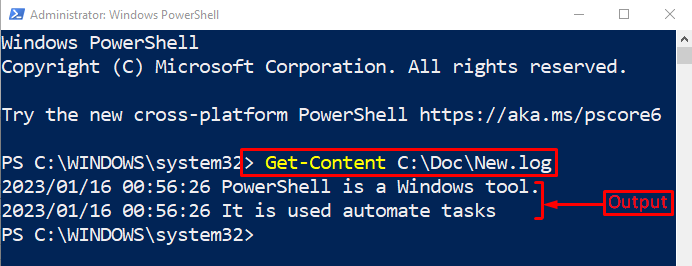This tutorial will exhibit a guide to create PowerShell log files.
How to Create/Generate a Log File in PowerShell?
The log file can be created in PowerShell by utilizing these approaches:
- Create a simple log file in PowerShell.
- Create a log file using a function in PowerShell ISE.
- Create a time-stamped log file using a function in PowerShell ISE.
Method 1: Create a Simple Log File in PowerShell
First of all, let’s create a simple log file in PowerShell. In this method, we will only use the PowerShell console and run the commands one by one.
Example
Here is a demonstration to create a simple log file in PowerShell:
> $log = "This is a simple log file"
> $log >> $file
According to the above code:
- First of all, create a variable and then assigned a new path where a new log file will be created and stored.
- After that, create another variable and specify a string as its value.
- Finally, use the “Redirect >>” operator to store the text or log to a file whose path was given at the start:
Let’s verify whether a log file was created or not in PowerShell by executing the given command:
The content of the log file has been fetched successfully, which signifies the existence of the log file.
Method 2: Create a Log File Using a Function in PowerShell ISE
Another method to create a log file in PowerShell is using the function in a script.
Example
This example will demonstrate the creation of a log file in PowerShell using the function:
{
Add-Content "C:\Doc\New.txt" $LogMessage
}
Log-File "This is a log"
Log-File "Created in PowerShell"
According to the above code:
- Firstly, define a function and then passed an argument inside the function parenthesis.
- After that, execute the “Add-Content” cmdlet and assign the path of the log file where the file will be stored.
- Finally, outside the function body, pass some string argument to it:
Similarly, execute the “Get-Content” cmdlet for verifying the content of the log file:
Method 3: Create a Time-Stamped Log File Using a Function in PowerShell ISE
The log file can also be created in PowerShell with a timestamp inside it. In this method, we will be using the “Get-Date” cmdlet to create a time-stamped log file in PowerShell.
Example
This example will demonstrate a method to create a time-stamped log file using a function in PowerShell:
function WriteLog{
Param ([string]$Log)
$TimeStamp = (Get-Date).toString("yyyy/MM/dd HH:mm:ss")
$Message = "$TimeStamp $Log"
Add-Content $File -value $Message
}
WriteLog "PowerShell is a Windows tool."
WriteLog "It is used automate tasks"
According to the above code:
- First of all, create a variable “$File” and assigned the path and name of the log file to be created.
- Next, define a function and use the “Param()” method to pass the “$Log” variable as an argument.
- Then, create the “$TimeStamp” variable and assign the “(Get-Date).toString(“yyyy/MM/dd HH:mm:ss”)” cmdlet to print the current date and time inside the log file.
- After that, create another variable “$Message”, specify the variable “$TimeStamp” of DateTime and the “$Log” variable passed into the “Param()” as an argument.
- Finally, use the “Add-Content”, add the “$File” variable where the file path is stored, use the “-value” parameter, and then add the “$Message” variable.
- Invoke the define function, and pass some strings argument to it:
Let’s run the “Get-Content” command to check whether the log file was created or not:
The output confirms that the log file was created in PowerShell.
Conclusion
A log file in PowerShell can be created by simply redirecting output to a text file. For that reason, the “Add-Content” cmdlet is used within a function. Moreover, a time-stamped log file in PowerShell can also be created/generated if required. This post has presented multiple methods to create a log file in PowerShell.






